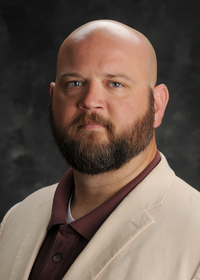Tree Planting Is Easy
Why Plant Trees
- To sustain the forest as a renewable resource
- To grow timber and wood products
- To provide wildlife food and cover
- To prevent soil erosion and protect streams, rivers, and lakes from sedimentation
- To shield us from wind, sun, noise, or unsightly areas
- To celebrate special occasions such as Arbor Day
- To establish a legacy or memorialize a loved one
Where to Plant Trees
- In cut-over areas
- In larger forest openings that receive full sunlight
- In woodlands where undesirable trees need to be replaced by more desirable ones
- In and around eroded gullies
- In retired fields
- In forests that need additional trees to achieve management goals
- In and around homes, schools, churches, factories, parks, cities, and towns
- Around landfills and along highways
What Kinds of Trees to Plant
- Some kinds of trees are best suited for certain types of soil or certain sections of the state. For instance, longleaf pine is best suited for southern Mississippi.
- Some kinds of trees, such as loblolly pine, are better and faster timber producers than others.
- Some kinds of trees are better suited for landscape purposes.
- Some trees, such as oaks, are better wildlife food-producers.
For more information about kinds of trees, their growth habitats, and uses, see Mississippi State Extension Publication 146 Know Your Trees, and consult your county Extension agent, Extension forester, or Mississippi Forestry Commission area forester.
How and Where to Get Seedlings
- Seedlings are usually sold in bundles, bags, or boxes of 100 to 1,000. You may want to order seedlings as a group, such as landowners, homeowners, youth groups, civic groups, church groups, and so forth.
- MSU Extension Forestry publishes an annual directory of forest tree nurseries. Contact your local Extension office to request a copy of MTN 4E Forest Seedling Availability from In-State and Regional Nurseries.
Care and Handling of Seedlings before Planting
- Seedlings usually are packed in bundles (open to air), boxes, or bags (sealed).
- If seedlings are in sealed bags, keep them refrigerated until planted (34–38˚F/1.1–2.2˚C).
- Stack bundles to allow enough air circulation to prevent heat buildup.
- Store the bundles in the shade, but where they will not freeze. Seedlings can be stored in bundles for several weeks if the temperature remains between 34 and 38˚F.
- Open bags or bundles only as needed for planting.
- Plant seedlings as soon as possible after you receive them.
- Do not haul seedlings in open trucks. Too much wind can cause excessive drying and needle burn.
Watering Seedlings
- Water seedlings stored in bundles every 2 or 3 days. You can use a garden hose. Water one end of the bundle until water runs out the other end. Turn the bundle over to be sure all parts are watered. Prop one end of the bundle up to let excess water drain out.
- If your seedlings are shipped in a sealed bag, no watering is necessary until after the bag is opened. Plant all seedlings in the bag as soon as possible, preferably by the end of the day it is opened.
Handling in the Field
- When transferring seedlings from the bag or bundle to a planting bag, dip the roots in water or a root slurry before putting them in the planting bag or bucket.
- Use a planting bag or bucket to carry seedlings in the field, and cover the roots with mud, wet moss, root slurry, or water.
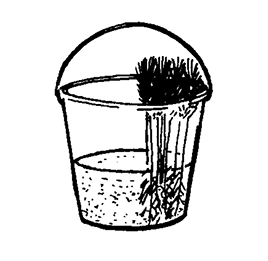
Correct: Put in mud or moss to cover roots. 
Incorrect: In hand, the roots dry out. Heeling In
If seedlings must be stored on-site without refrigeration for a long period of time, they can be heeled into the ground.

1. Dig a V-shaped trench in a shady place. 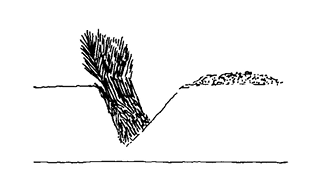
2. Break bundles and spread out evenly. Heeled-in seedlings can be removed from the trench when you are ready to plant. Remove only as needed, and immediately place them in a planting bag or bucket. Keep seedling roots covered with mud, wet moss, or root slurry until you plant them.
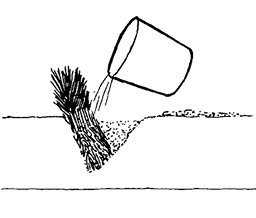
3. Fill in with loose soil, and water well. 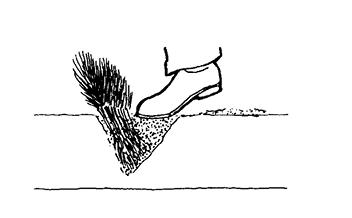
4. Complete filling in trench, and firm soil with feet. Planting Seedlings by Hand
Planting by hand can be performed on any site.
With Dibble or Planting Bar


1. Insert dibble at angle shown, and push straight up. 
2. Remove dibble, and place seedling at correct depth. 
3. Insert dibble 2 inches toward planter from seedling. 
4. Pull handle toward planter, firming soil at bottom of roots. 
5. Push handle forward from planter, firming soil at top of roots. 
6. Insert dibble 2 inches from last hole. 
7. Push forward, then pull backward to fill hole. 
8. Fill in last hole by stamping with heel. Other Tree-Planting Tools
- Post-hole digger
- Shovel
- Iron bar
- Spade
Machine Planting
With Mechanical Tree Planter
Mechanical tree planters are pulled by tractor. This process is often called machine planting. Machine planting is best suited to retired farm land or mechanically prepared planting sites.
While planting quality may not be greater with machine planting, a mechanical planter can plant more seedlings than an individual with hand planting tools.
How Many Seedlings to Plant
The number of tree seedlings to plant will vary with the seedling type and landowner objectives. Spacing determines the number of seedlings planted per acre. Wider spacing between rows (12 feet or more) permits equipment access into the stand.
When ordering seedlings, add 5 percent to the calculated total to allow for cull trees that are too small to plant, or shortages in packing.
Seedling Type
Trees per Acre (tpa)
Potential Spacing
First-generation pine
Second-generation pine
500–650
8 ft x 11 ft (495 tpa)
8 ft x 9 ft (605 tpa)
7 ft x 10 ft (622 tpa)
Second-generation pine
Mass controlled pollinated (MCP) pine
Container-grown loblolly pine
Oak
450–550
7 ft x 12 ft (518 tpa)
9 ft x 9 ft (537 tpa)
8 ft x 10 ft (544 tpa)
9 ft x 10 ft (484 tpa)
8 ft x 11 ft (495 tpa)
Varietal pine
Container-grown longleaf pine
Hardwoods
400–500
10 ft x 11 ft (396 tpa)
10 ft x 10 ft (435 tpa)
9 ft x 10 ft (484 tpa)
8 ft x 11 ft (495 tpa)
Cost-share programs may require more trees per acre than some of these spacings.
Additional Reading
VanderSchaaf, C. L. 2023. Forest seedling availability from in-state and regional nurseries, 2023–2024. Department of Forestry, Management Technical Note 4E. Mississippi State University.
Self, A. B. 2022. Planting southern pines: A guide to species selection and planting techniques. Mississippi State University Extension Publication 1776.
Self, A. B. 2023. Artificial regeneration of bottomland hardwoods. Mississippi State University Extension Publication 3486.
Self, B., & Rousseau, R. J. 2021. What are genetically improved seedlings? Mississippi State University Extension Publication 2617.
Publication 160 (POD-02-24)
By Brady Self, PhD, Associate Extension Professor, Forestry, from earlier versions by John Kushla, PhD, Extension/Research Professor (retired), Andrew W. Ezell, PhD, Forestry, Professor Emeritus, and W.R. Mattoon, former Extension Forester, USDA Forest Service.
The Mississippi State University Extension Service is working to ensure all web content is accessible to all users. If you need assistance accessing any of our content, please email the webteam or call 662-325-2262.




